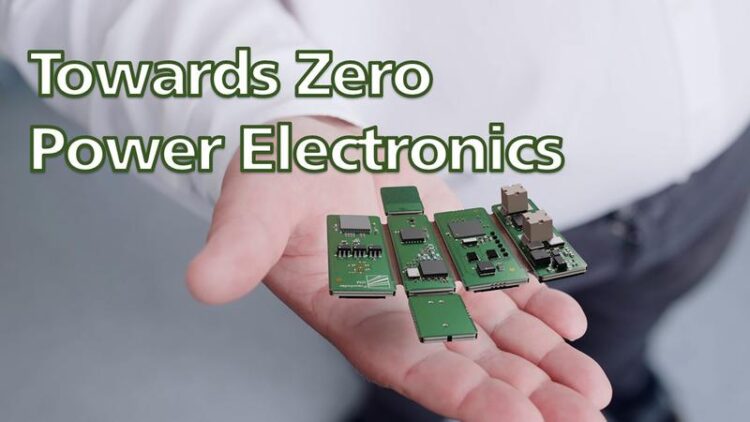Greening the Internet of Things

Watch project video to discover more about the potential future for ZEPOWEL’s technologies and components. https://www.youtube.com/watch?v=GotGWj1YkBc
© loewn logulagu gmbh / © Fraunhofer IZM
Sensors have become the ubiquitous companions of our lives. Whether knowingly or not, we use them every day to collect, process, and interpret data and help us make sense of the world around us. The demand for connected devices keeps growing – in particular in the Internet of Things, or IoT for short. The Fraunhofer flagship project ZEWOPEL has shown successfully how all of these sensor systems can become extremely energy efficient or even completely autonomous. The potential result: Up to 20% less carbon emissions in Germany alone.
With billions of sensors littering our increasingly connected world, their power supplies have become a factor to contend with for the environment, especially for industrial use. Many of the devices that constitute the Internet of Things are already intricately tied to each other, with a mass of sensors forming individual nodes. Early IoT devices would communicate with each other and share their data with little concern for energy efficiency, making many of the urgently needed IoT applications too heavy a burden on the environment for them to be rolled out on a true industrial scale or indeed making them unsuitable choices for upgrading. Now, the nine Fraunhofer organizations behind the ZEWOPEL project, standing for “Towards Zero Power Electronics”, have shown that the digital revolution and the energy revolution do not have to exclude each other.
With years of active research and development on everything from integrated sensors and signal processing or energy harvesting and improved storage technologies to efficient wireless communication between connected IoT devices, the ZEWOPEL platform was set up to optimize the entire universe of IoT systems. Its unique approach relied not only on its use of modular technology that can be tailored to match most IoT applications, but also on the ability of future sensor nodes to become autonomous of external power supplies.
The project partners’ work was put to the test in two characteristic use cases of the Internet of Things: Smart cities and smart fabrication. For the former, autonomous sensor nodes would monitor air quality, such as nitrous oxide or fine particulate emissions, in real time and with exceptional energy efficiency. In smart factories, IoT nodes would be the backbone of a connected production system that tracks and controls the state of machines, engines, or pumps. In particular when machines idle, this ability to respond immediately could help reduce the overall energy consumption by a massive margin.
All contributors to the project convened for the concluding session of the ZEPOWEL project to present their shared results and commercialization strategy to a high-profile audience of experts from industry and academia. The potential use cases for the proposed sensors are vast and diverse, reaching from modern agriculture and manufacturing to holistic systems for a more powerful and sustainable Internet of Things.
Fraunhofer’s flagship project ZEPOWEL
No fewer than nine organizations conducted ZEPOWEL as a flagship project of the Fraunhofer Society between 2017 and 2021: Under the careful guidance of the Fraunhofer Institute for Reliability and Microintegration IZM and the Fraunhofer Institute for Integrated Systems and Device Technology IISB, these partners included the Fraunhofer Research Institution for Microsystems and Solid State Technologies EMFT, the Fraunhofer Institute for Cognitive Systems IKS, the Fraunhofer Institute for Applied Solid State Physics IAF, the Fraunhofer Institute for Integrated Circuits IIS, and its Adaptive Systems division EAS, the Fraunhofer Institute for Photonic Microsystems IPMS, and the Fraunhofer Institute for Silicon Technology ISIT.
Wissenschaftliche Ansprechpartner:
Jan Hefer I Fraunhofer Institute for Reliability and Microintegration IZM l Phone +49 30 46403-141 l Gustav-Meyer-Allee 25 | 13355 Berlin | www.izm.fraunhofer.de | jan.hefer@izm.fraunhofer.de |
Originalpublikation:
https://www.izm.fraunhofer.de/en/news_events/tech_news/greening-the-internet-of-…
Weitere Informationen:
Media Contact
All latest news from the category: Information Technology
Here you can find a summary of innovations in the fields of information and data processing and up-to-date developments on IT equipment and hardware.
This area covers topics such as IT services, IT architectures, IT management and telecommunications.
Newest articles

Innovative 3D printed scaffolds offer new hope for bone healing
Researchers at the Institute for Bioengineering of Catalonia have developed novel 3D printed PLA-CaP scaffolds that promote blood vessel formation, ensuring better healing and regeneration of bone tissue. Bone is…

The surprising role of gut infection in Alzheimer’s disease
ASU- and Banner Alzheimer’s Institute-led study implicates link between a common virus and the disease, which travels from the gut to the brain and may be a target for antiviral…

Molecular gardening: New enzymes discovered for protein modification pruning
How deubiquitinases USP53 and USP54 cleave long polyubiquitin chains and how the former is linked to liver disease in children. Deubiquitinases (DUBs) are enzymes used by cells to trim protein…



